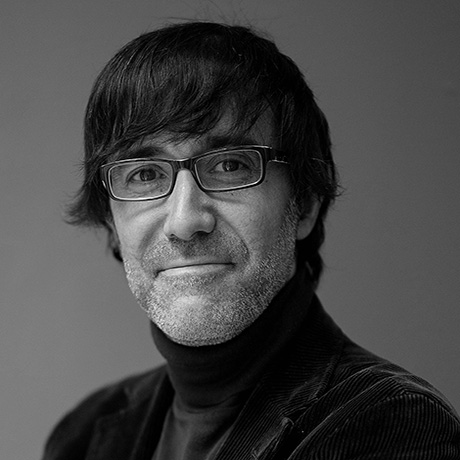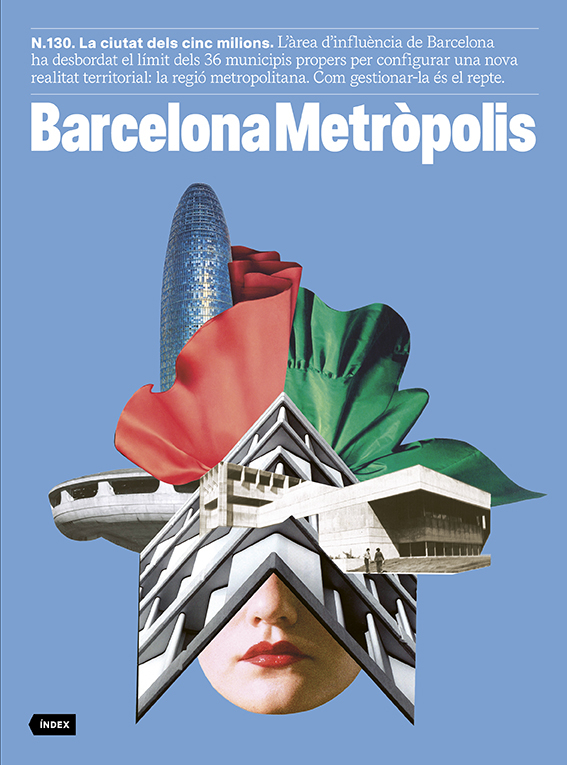Dispersed urbanisation: An overlooked challenge
- Dossier
- Apr 24
- 12 mins

The Barcelona of five million encompasses not only the territory of dense and compact cities but also a multitude of scattered residential fabrics, which have burgeoned, especially since the 1980s. This dispersion has long been ignored, leaving many territories with unresolved issues and challenges.
In the metropolitan area, within the vast urban region that makes up Barcelona, the territory is no longer solely shaped by high population concentrations in the biggest cities. Since the 1980s, municipalities with populations ranging from 5,000 to 50,000 have progressively assumed a pivotal role in understanding what amounts to a general and gradual dispersal of urbanisation across the territory, especially in areas previously untouched by urbanisation trends.
The spread of settlements and economic activities has shaped an urbanisation that diverges significantly from the familiar concept of linear urban growth. Instead of a single, linear expansion, we see multiple areas experiencing linear growth, which today exhibit a settlement pattern characterised and defined by dispersed urbanisation.
The physical expansion of built urban space and the dynamics of suburbanisation have led to the emergence of what Richard Ingersoll termed in 1999 as sprawlscapes or “landscapes of dispersion”. This concept describes the spread of elements that once constituted the concentrated habitat and visual order of the urban built environment, first in intermediate cities and later in the territories of smaller-sized municipalities.
The genesis of a dual metropolis
In 1996, architect Mario Gandelsonas wryly commented on the dispersion of urbanisation, drawing attention to the lifestyle of metropolitan inhabitants with the following statement: “… those commuting from the outer suburbs go from their air-conditioned single-family homes to their air-conditioned cars, to their air-conditioned offices, then to restaurants with air conditioning, and back to their cars and homes again. In their leisure time, they go to air-conditioned shopping centres, and occasionally to air-conditioned cinemas.”
Back then, Gandelsonas wasn’t talking about Barcelona whatsoever; he was referring to the major American conurbations. There, the phenomenon of dispersed urbanisation had already firmly established itself as the primary characteristic of the urban model. Almost thirty years later, it is still surprising how readily we can recognise the trajectory outlined in Gandelsonas’ paragraph and reflect on the territory of the Barcelona metropolitan region using the same framework. How has this phenomenon arisen? What has driven the expansion of this dispersed urbanisation across the metropolitan territory of the Barcelona region?
Propelled by the efforts of the first democratic municipalities, the 1980s saw the beginning of the major urban reconstruction project for compact Catalan cities following the Franco regime. However, it was also during this decade that suburban growth unexpectedly gained prominence.
Thus, precisely as one of the flagship initiatives of the urban regeneration project, Ciutat Vella’s Integral Rehabilitation Area (ARI in Spanish), was taking shape in Barcelona in 1987, it was also a period when the reality of the Catalan suburb was evolving and expanding more noticeably, assuming a predominant presence in many areas. For instance, between 1987 and 1989, the construction of single-family homes never dropped below 45% of the new housing built across virtually the entire territory of the province of Barcelona – 304 out of the 311 municipalities comprising the region.
The consolidation of suburbanisation cannot be fully understood in relation to the processes of metropolitanisation in the Barcelona region without acknowledging the emergence of a new type of property: the townhouse or row house. Townhouses led the exponential growth of the Catalan suburb from the late 1980s and throughout the subsequent decade, driving the development of larger and more uniform suburban landscapes across the region. Consequently, the landscape pattern of “single-family home-roundabout-petrol station-motorway” became just as common as the domestic sequence of “single-family home-garden-pool-garage”.
This surge in dispersed urbanisation across the Barcelona region becomes evident when examining specific housing construction data. For instance, over the 20-year period from 1985 to 2005, the average rate of construction of single-family homes in the 311 municipalities of the province of Barcelona reached one new house per hour.
Considering this regional dynamic of dispersed urbanisation, we can assert that there is a clear distinction between the suburbanisation that characterised the period from 1960 to 1975 – when most first-generation housing estates were built – and the current dispersed urbanisation. Instead, this forms part of a process of redefining metropolitanisation dynamics through the dispersion, on a regional scale, of the nodal elements that previously formed the fundamental pillar of the urban structure in traditional compact cities.
A biased diagnosis
For a long time there has been a skewed perception of the phenomenon of dispersed urbanisation, linking this form of urban growth with the tradition of previous suburbanisation processes that unfolded in Catalonia since the early 20th century. These processes were often oversimplified through a romanticised notion of the garden city or the nostalgic visions of cottage and garden life.
This reflects a problem in diagnosis and approach, which has turned dispersed urbanisation into a challenge that has been largely ignored. There are at least four major issues that help us understand this misguided diagnosis of dispersed urbanisation:
— The morphology of low-density urbanisation and the tradition of suburbanisation.
Firstly, one of the primary challenges in understanding the implications of dispersed urbanisation is that its morphological appearance has been closely linked to the construction of suburban territories resulting from earlier urbanisation processes. These processes have been widely recognised across many sectors of the metropolitan region since the 1960s.
— Focus on the historic city in the latter decades of the 20th century.
Secondly, it is worth highlighting the significant focus that urban planning and urban policy placed on the reconstruction and regeneration of the dense and compact city from the early years of the 1980s and throughout the following decade. In this sense, the concern to provide substance to this compact city urbanism was counterbalanced by the difficulties in integrating the process of urban dispersion into the framework of urban dynamics diagnosis, which was occurring throughout the entirety of the five-million-strong city.
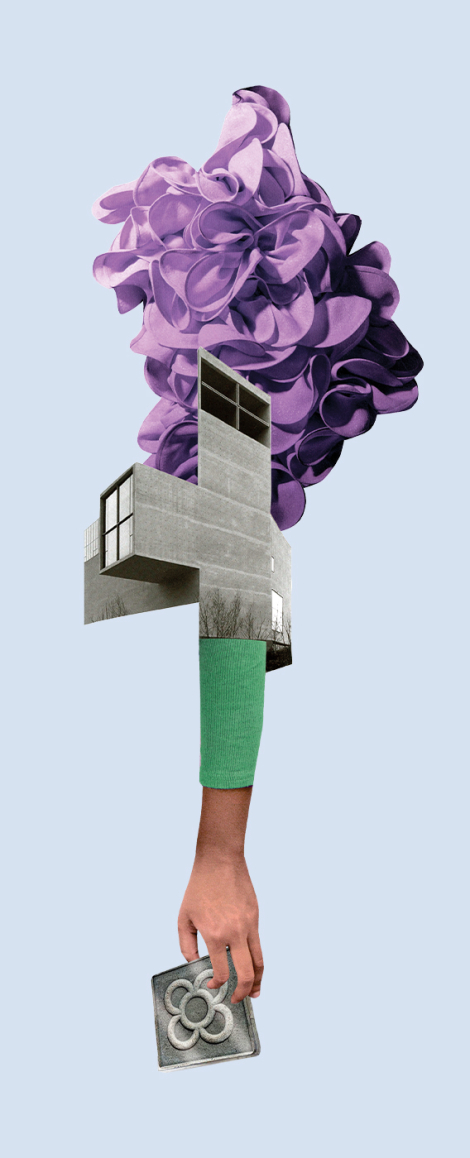 Illustration ©Rebeka Elizegi
Illustration ©Rebeka Elizegi— An informed perspective against functionalist architecture.
Thirdly, at a time when high-density urban planning and extensive concentrations of high-rise housing in housing estates dominated the urban landscape, the morphological typology and territorial structure of dispersed urbanisation were seen as a lesser evil and, in some cases, even viewed positively.
— The cultural explanation of low-density urbanisation mechanisms.
Lastly, we must not overlook the diagnosis, which is certainly flawed, concerning the underlying mechanisms of this phenomenon. On numerous occasions, a purely cultural explanation has been put forward: the urban dweller’s preference for less crowded living spaces, in close proximity to the countryside and natural landscapes. However, from an economic standpoint, families’ housing preferences are actually shaped by the residential market. Therefore, it is crucial to consider the price differences of existing housing between compact urban areas, where prices have steadily increased, and a significant portion of new low-density developments, which concentrate more affordable attached single-family homes.
Following the phenomenon of dispersed regional urbanisation
In one of the early issues of the Cities magazine published at the turn of the century (April 2010),[1] specifically aimed at presenting different perspectives on dispersed urbanisation, Andrew Kirby and Ali Modarres concluded the volume and their article “The suburban question: Notes for a research program” with the following statement: “… we need to abandon our tendencies to over-generalize or dismiss whole sections of our metropolitan areas as social or environmental errors. If planning and urban policy are to remain relevant to the realities of our cities, they need to embrace the form, social structure, and economic landscapes of our cities. Moving away from nostalgia, manifested in excessive obsession with pre-industrial or industrial urban forms, would be a healthy first step.”
The first step towards reimagining the territory, while steering clear of nostalgia for the traditional city, can be taken by considering elements such as the complexity and diversity inherent in low-density environments. It means avoiding the mere replication of density characteristics seen in traditional cities and instead proposing new forms of urban intensity tailored to the features and potentials of dispersed urbanisation. It also requires moving beyond the superficiality of standard formats for public spaces, which have traditionally defined the urban landscape. In dispersed habitats, these spaces lack the spatial relationships and urban configurations that imbued them with significance in compact cities. Furthermore, it involves suggesting alternatives to the mass-produced, anonymous architecture that has long dominated residential habitats in dispersed areas.
It is only through this approach that we can begin to envision integrating dispersed regional urbanisation into the roadmap of territorial planning for the five-million-strong city. By doing so, we can put together a comprehensive project to “inhabit” dispersed urban areas and introduce new levels of territorial complexity and urban intensity. This is the only way to address the questions posed by the challenges of a territory still on stand-by, a non-city still in wait.
References
AMB [Barcelona Metropolitan Area]. Editorial Service for the Master Plan. Barba, J., Balliano, M., Maluquer, N. and Sisó, R. (coordinators) Quaderns PDU Metropolità. Directrius urbanístiques. Teixits residencials. Urbanitzacions disperses. AMB, Barcelona, 2017.
Galdensonas, M. “L’arquitectura d’exúrbia”. Present i futurs. Arquitectura a les ciutats. XIX Congress of the International Union of Architects, UIA (34-39). Professional Architects’ Association / Centre de Cultura Contemporània de Barcelona, 1996.
Kirby, A. and Modarres, A. “The suburban question”. Cities. The international Journal of Urban Policy and Planning, 27(2). April 2010.
Muñoz, F. “Paisajes aterritoriales, paisajes en huelga”. La construcción social del paisaje, edited by Nogué, J. Editorial Biblioteca Nueva, Madrid, 2007.
Muñoz, F. UrBANALización. Paisajes comunes, lugares globales. Gustavo Gili, Barcelona, 2008.
Muñoz, F. Local, local! La ciutat que ve. Catalogue of the Commemorative Exhibition of the 30 Years of Democratic Municipalities. Barcelona Provincial Council / CCCB, 2010.
Muñoz, F. (coordinator) Estratègies vers la ciutat de baixa densitat: de la contenció a la gestió. “Estudis” collection, “Territori” series, 9. Barcelona Provincial Council, Barcelona, 2011.
Muñoz, F. “Catalunya Ciutat(s): entre la ciutat total i el camp urbanitzat”. Medi Ambient, Tecnologia i Cultura, 51, 24-35. 2014.
Muñoz, F. “De ciutadans a territoriants: habitant el territori en l’era de la urbanització regional dispersa”. Catalunya futur verd, 249-264. Department of Territory and Sustainability – Generalitat Government of Catalonia, 2018.
[1] With the intriguing title “The suburban question”. Cities. The international Journal of Urban Policy and Planning, 27(2). April 2010.
Recommended reading
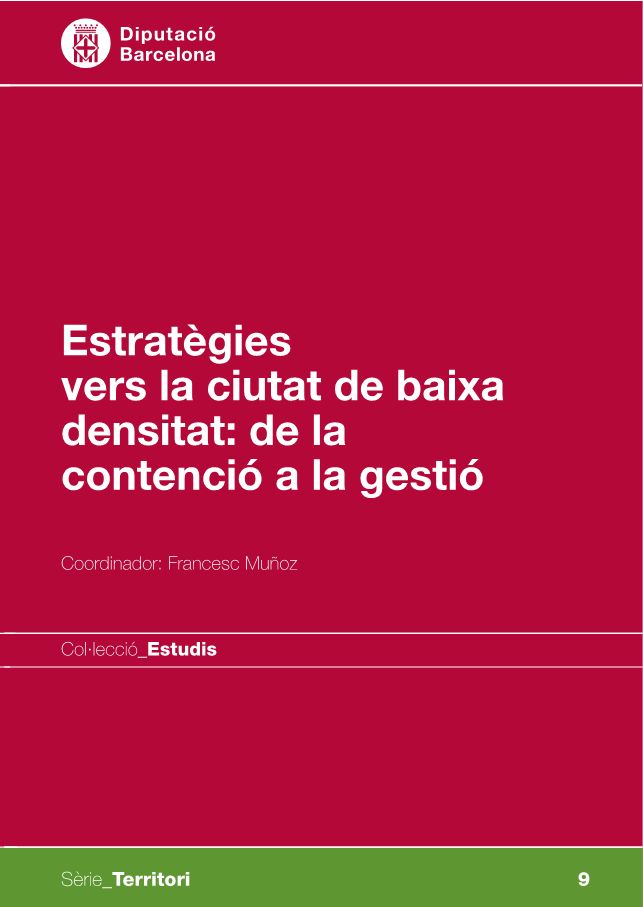 Estratègies vers la ciutat de baixa densitat: de la contenció a la gestióFrancesc Muñoz (ed.) Diputació de Barcelona, 2011
Estratègies vers la ciutat de baixa densitat: de la contenció a la gestióFrancesc Muñoz (ed.) Diputació de Barcelona, 2011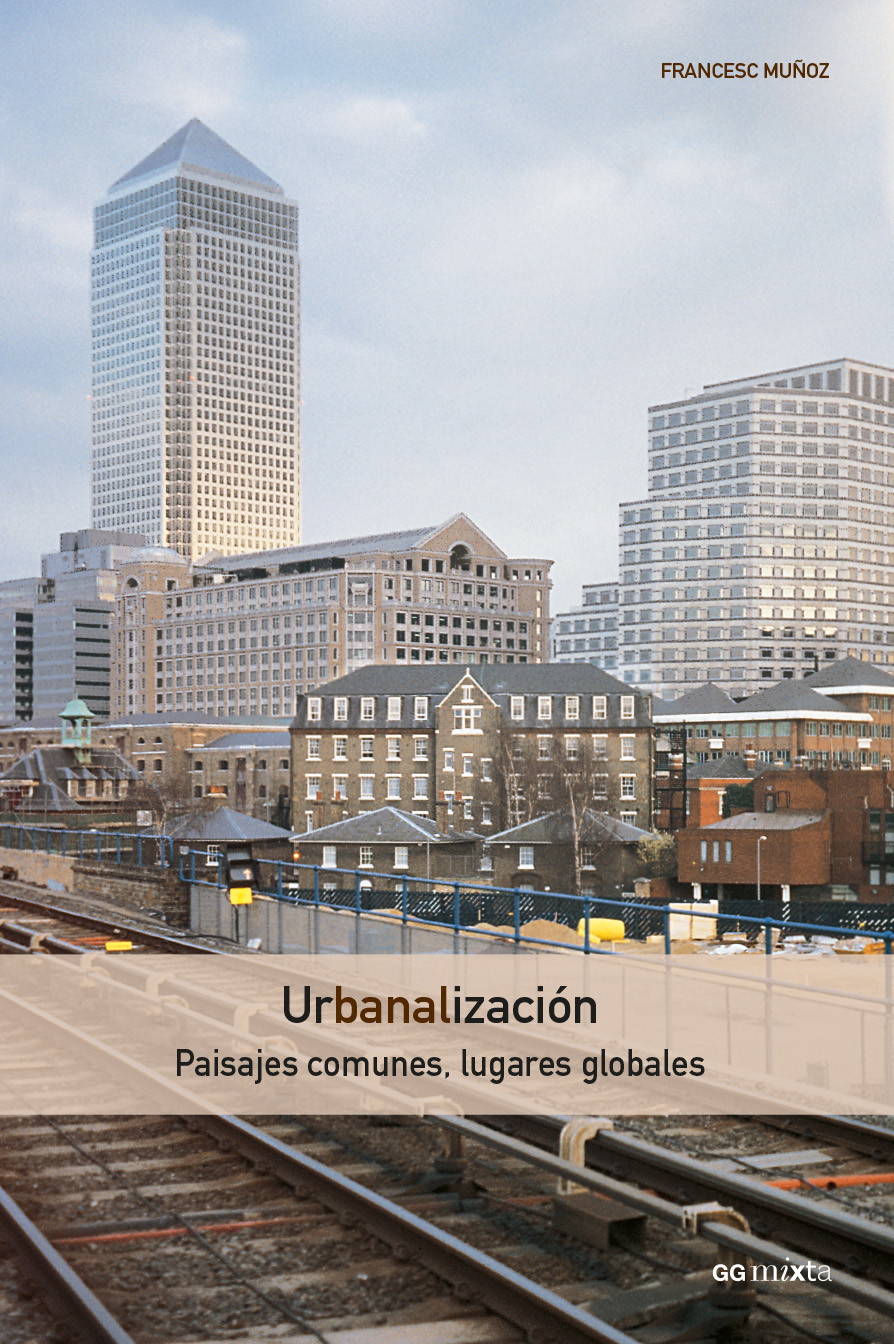 UrBANALización. Paisajes comunes, lugares globales Gustavo Gili, 2008
UrBANALización. Paisajes comunes, lugares globales Gustavo Gili, 2008
The newsletter
Subscribe to our newsletter to keep up to date with Barcelona Metròpolis' new developments



